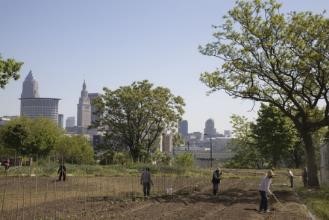On February 25, the NEOSCC Board voted unanimously to approve and endorse the Vibrant NEO 2040 Vision, Framework and Action Products. We are sharing an “Initiative A Day” so you can gain a better understanding of the vision and framework! If you would like to read all of the Initiatives, you can download them here: Recommendation and Initiatives. You can access a pdf of the entire vision chapter here. The vision chapter contains all 41 initiatives, development strategies, indicators, and matrices that identify how the recommendations, initiatives and indicators all relate.
Show your support for Vibrant NEO 2040 by adding your name to our Champions of Vibrant NEO 2040 list here.
Initiative 8.1: Support the expansion of Community Supported Agriculture (CSA’s), farmer cooperatives, farm-to-school programs, and other existing mechanisms that support sustainable agriculture and enhance food access.
WHAT THIS MEANS. The entrepreneurial ecosystem around the local foods movement is expanding steadily. It includes a diverse range of actors: community supported agriculture (CSA) cooperatives, incubators, research extensions, farmers markets, and many others. Many cities and towns throughout the country and Northeast Ohio have moved in recent years to establish farmers markets and amend zoning laws to allow for orchards, crops, and in some cases small-scale livestock. Fewer, however, have invested in the intermediate segments of the local food supply chain, where the most value is added. Such investments have included:
• Granting vacant or abandoned municipal- or land bank owned buildings and land to local cooperatives or CSAs for sorting, processing, and/or distribution of produce
• Allocating community development block grant (CDBG) and other economic development funding to startup farms and food processing enterprises
• Amending procurement standards and policies to privilege locally-sourced foods
Farm-to-School programs are a good example of intentional efforts to build linkages between a local foods industry and institutions, resulting in a host of benefits to all parties involved. The Ohio State University extension service maintains a resource for farm-to-school initiatives throughout the state. Several Northeast Ohio community school districts, including the Cleveland Metropolitan School District, have inaugurated farm-to-school programs using state-level resources and programs such as that offered by the OSU Extension.
WHY THIS IS IMPORTANT. The local foods movement should no longer be viewed as a fad, but as an important economic and community development paradigm. Investing in networks of local producers, processors, and consumers builds individual wealth through new opportunities, activates vacant and underutilized space, connects communities, and keeps value within the region.
GETTING IT DONE. This initiative is relatively easy to implement, as there are a many ways that various public entities can support the local foods system. Local governments, land banks, and school districts should lead the way in this effort given their ability to financially support local producers and processors through amended zoning regulations, procurement standards, building and land cleanup and acquisition. Entities participating in vacant land inventories and evaluation efforts proposed above (3.1 and 3.4), especially local governments and land banks, should consider the needs of local food producers and processors and encourage their participation in those processes.
BEST PRACTICE: Rid-All Green Partnership has turned an empty and forgotten piece of land in Cleveland’s Kinsman neighborhood into an urban farm where they grow produce to bring healthy, local food to area institutions and citizens and train others on this work. They have two greenhouses and four hoop houses in Cleveland’s Forgotten Triangle. The Rid-All Farm harvests 150 to 200 pounds of vegetables a week that’s distributed to local restaurants, institutions and consumers. TOOL: The 30 Mile Meal : Wondering where to find local peaches or lamb? Or a restaurant that serves great food and supports local farmers? The 30 Mile Meal™ celebrates and promotes those producing, selling and serving local foods within a 30-mile radius of Athens, Ohio. The 30 Mile Meal provides a shared identity for their many farmers, specialty food producers, farmers and retail markets, food events, and independently-owned eateries and bars featuring locally sourced menus. The 30 Mile Meal Project is a collaboration of the Athens County Convention and Visitors Bureau, the Appalachian Center for Economic Networks (ACEnet) and 130 local food partners.
PILOT PROJECT: The Oberlin Project local food system strategy: The growth of local food systems includes a comprehensive plan to increase local food processing and distribution, utilize waste as an input to local agriculture and promote urban agriculture. The Oberlin Project has organized a network of local farmers who are exploring new production techniques that store large amounts of carbon in soil and plant biomass. This provides a promising solution to climate change, offsetting the carbon releases of the community through investments in farms in the surrounding area. Local Food Systems development in the greater Oberlin area will unfold through a four-step process that includes: assessment, investment, capacity, and replication.
| Lead | Municipalities, Townships, Counties; Land Banks; Nonprofit Organizations; School Districts |
| Target Community | Strategic investment areas, asset risk areas, cost risk areas |
| Implementation Complexity | Low |
These recommendations, initiatives, and products, are not one-size-fits all and some aspects of the initiatives won’t be applicable everywhere in the 12-county region. The Vibrant NEO 2040 Vision, Framework and Products are intended inspire and guide decision-making at the Metropolitan Planning Organization (MPO), Council of Government, and local levels to ensure that land use, transportation, and environmental considerations are simultaneously addressed by their processes. Ultimately, the implementation of Vibrant NEO 2040 is up to Northeast Ohio’s communities and residents. But regardless of the applicability of each initiative to any particular part of the region, the goal for each community within the Vision is the same: stability, prosperity, and a high quality of life for all of its residents.

